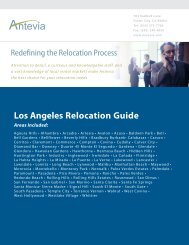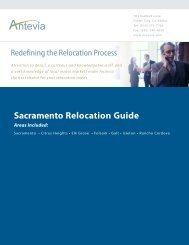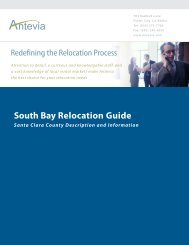San Francisco Relocation Guide - Antevia
San Francisco Relocation Guide - Antevia
San Francisco Relocation Guide - Antevia
You also want an ePaper? Increase the reach of your titles
YUMPU automatically turns print PDFs into web optimized ePapers that Google loves.
ascending to the Nob Hill sector. Relative to other areas, the Tenderloin is the only<br />
largely working-class neighborhood within the downtown area. The uphill area of the<br />
neighborhood is known as the "Upper Tenderloin".<br />
The Dot Com boom in the late 1990s brought a great deal of redevelopment and resident<br />
inhabitation to the SOMA district in particular, but some revitalization funds put into the<br />
Tenderloin made a prominent impact —evident today by a much broader section of new<br />
ethnic restaurants and bars, as well as a more long-term young working class.<br />
Area<br />
The Tenderloin is not quite as easy to define as other <strong>San</strong> <strong>Francisco</strong> neighborhoods. A<br />
conservative description is for it to be bounded on the North by Post Street, on the East<br />
by Taylor and 6th Streets, on the South by Mission Street and on the West by Van Ness<br />
and 9th Streets. The northern boundary with Nob Hill is especially hard to define and can<br />
range as far north as Pine Street in western sections of the Tenderloin, such as the Polk<br />
Gulch neighborhood.<br />
The Tenderloin roughly lies west of Union Square, south of Nob Hill, east of Western<br />
Addition and Van Ness corridor and north of SOMA ("South of Market").<br />
It includes neighborhoods referred to as Mid-Market, Civic Center, Theater District,<br />
Lower Nob Hill, Polk Gulch, and Little Saigon. 'The Tenderloin' is almost never actually<br />
used in any real-estate listing; instead it is usually one of the above neighborhood names.<br />
The extension of the Tenderloin south of Market Street in the vicinity of Sixth, Seventh,<br />
and Mission Streets is known locally as Mid-Market and is "Skid Row", or sarcastically,<br />
as "the Wine Country", an allusion to "winos" (street- dwelling alcoholics). The northern<br />
part of it beginning at Post Street is called a variety of nicknames including the Upper<br />
Tenderloin, "Lower Nob Hill" (widely used in real estate listings), or facetiously "The<br />
Tendernob", "Tenderloin Heights", or the "Trenderloin" (a reference to the area's<br />
increasing gentrification.) The eastern extent where it meets Union Square is known as<br />
the Theater District. Part of the western extent of the Tenderloin, Larkin and Hyde Streets<br />
between Turk and O'Farrell, was officially named "Little Saigon" by Mayor Gavin<br />
Newsom shortly after his election in 2004.<br />
Nestled between successful commercial areas and high priced residential areas, parts of<br />
the Tenderloin have historically resisted gentrification, maintaining a seedy character and<br />
reputation for crime. The region includes City Hall, <strong>San</strong> <strong>Francisco</strong> Public Library, and the<br />
Asian Art Museum. Abandoned architectual landmarks are also located here, such as the<br />
old Hibernia Bank located on the dilapidated corner of Jones and McAllister Street, near<br />
a methadone clinic and Saint Anthony's soup kitchen.







